From the Manual Of Tropical And Subtropical Fruits
by Wilson Popenoe
The Mango
Propagation
Like many other fruit-trees, the mango has been propagated in the
tropics principally by seed. In some instances seedling trees produce
good fruits; this is particularly true of certain races, such as the
Manila or Philippine. But in order to insure early bearing,
productiveness, and uniformity of fruit, it is necessary to use
vegetative means of propagation. Inarching, budding, and grafting are
the methods most successfully employed.
The seedling races of
the tropics are, so far as has been observed, polyembryonic in
character. Three to ten plants commonly grow from a single seed. Since
these develop vegetatively from the seed tissues, they are not the
product of sexual reproduction, but may be compared to buds or cions
from the parent tree. Most of the grafted Indian varieties, on the
other hand, have lost this characteristic. When their seeds are planted
a single young tree develops, and this is found to differ from its
parent much as does a seedling avocado or a seedling peach. Usually the
fruit is inferior, and the tree may be quite different in its bearing
habits.
Dr. Bonavia, a medical officer in British India who did
much to stimulate interest in mango culture, at one time took up the
question of seedling mangos and wrote several articles advocating their
wholesale planting. He argued that not only would many new varieties,
some of them superior in quality, be obtained in this way, but also
earlier and later fruiting kinds, and perhaps some suited to colder
climates.
Just what percentage of seedling mangos will produce
good fruit depends largely on their parentage. Seedlings of the fibrous
mangos of the West Indies are invariably poor, while those from budded
trees of such varieties as Alphonse and Pairi, although in most
instances inferior or rarely equal or superior to the parent, are
practically never so poor as the West Indian seedlings. At the
Saharanpur Botanic Gardens, in northern India, some experiments were
conducted between 1881 and 1893 to determine the average character of
seedlings from standard grafted varieties. The results led to the
conclusion that seedlings of the Bombay mango were fairly certain to
produce fruit of good quality. An experimenter in Queensland, at about
the same time, reported having grown seedlings of Alphonse to the
fourth generation, all of which came true to the parent type.
Experience
in the United States has shown, however, that degeneration is common. A
number of seedlings of Mulgoba have been grown in Florida, but very few
have proved of good quality. There is a tendency for the fruits to be
more fibrous than those of the parent. The whole question is probably
one of embryogeny. When monoembryonic seeds are planted, the fruit is
likely to be inferior to that of the parent, if the latter was a choice
variety; with polyembryonic seeds, even though of fine sorts like the
Manila, the trees produce fruit closely resembling that of the parent.
The
embryogeny of the mango cannot be discussed at great length here. It is
not yet thoroughly understood, although it has been studied by several
investigators. The most recent account and the only one which has been
undertaken with the horticultural problems in mind, is that of John
Belling, published in the Report of the Florida Agricultural Experiment
Station for 1908. Belling says:
"In the immature seed of the
sweet orange E. Strasburger has shown by the microscope, and Webber and
Swingle have proved by their hybridizing experiments that besides the
ordinary embryo which is the product of fertilization, the other
embryos present in the young or mature seeds arise by the outgrowth of
nucellar cells into the apical part of the embryo-sac. The
first-mentioned embryo, when present, is liable to any variation which
is connected with sexual multiplication, - the vicinism of H. De Vries.
The remaining embryos, on the other hand, presumably resemble buds from
the tree which bears the orange in whose seed they grow, in that they
inherit its qualities with only a minor degree of variation."
The
behavior of the mango has suggested a similar state of affairs. Belling
goes on to quote Strasburger's account of the embryogeny of the mango,
and describes his own investigations:
"Even in the unopened
flower bud the nucellar cells at the apex of the embryo sac which are
separated from the sac only by a layer of flattened cells, are swollen
with protoplasm. In older fruits it may be noticed that the cells
around the apical region of the sac except on the side near the raphe
are also swollen. The adventitious embryos arise from these swollen
cells, which in fruits 7 mm. long with ovules 3 mm. long divide up,
sometimes forming the rudiments of a dozen or more embryos, but often
fewer. The nucleated protoplasm on the embryo-sac wall is undivided
into cells, and is thick opposite the places where embryo formation is
going on."
Belling worked with fruits of the No. 11 mango,
seedling race of Florida identical with the common mango of the West
Indies, Mexico, and Central America. He was not able to determine
whether the egg-cell develops into an embryo, or whether all of the
embryos are adventitious, - the egg-cell being crowded out or destroyed
in some other way. If the fertilized egg-cell develops and is
represented in the mature seed, the plant arising from it should
exhibit variation; but the seedling races are so constant that it seems
probable that the egg-cell is lost at some stage in the development of
the fruit, and that all of the embryos are normally adventitious. There
is as yet no proof, however, that fruits will develop on this or other
mangos unless the flowers are pollinated. The subject is an important
one and will repay further investigation.
It has been observed
in Florida that monoembryonic grafted varieties, such as Mulgoba, will,
when grown from seed, sometimes revert to polyembryony in the first
generation (Fig. 10).
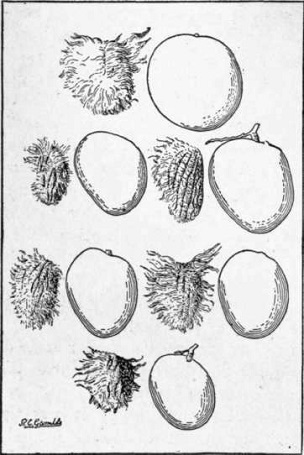
Fig. 10. Seedlings of grafted Indian mangos usually do not produce
fruit exactly like the parent. Each of the fruits here shown represents
a tree grown from a seed of the Mulgoba mango. The variations in size
and shape of fruit, and in the amount of fiber around the seed, are
noteworthy. (X 1/6)
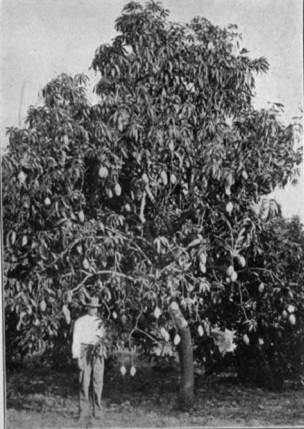 | 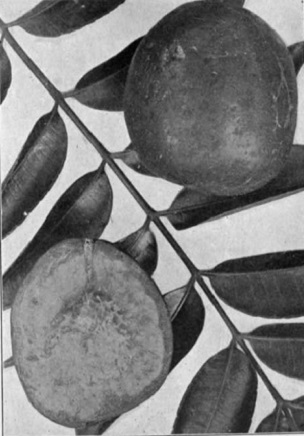 | | Plate VI. Left, the Sandersha mango; right, the ambarella. |
G. L. Chauveaud1
has advanced the theory that polyembryony is a more primitive state
than monoembryony, which would seem to be borne out by this
observation; for it must be true that the choice mangos of India which
have been propagated by grafting for centuries are less primitive in
character than the semi-wild seedling races.
Inarching is an
ancient method of vegetative propagation. While several writers have
attempted to show that it was not known in India previous to the
arrival of Europeans, and that the Jesuits at Goa were the first to
apply it to the mango, others have held the belief, based on researches
in the literature of ancient India, that the Hindus propagated their
choice mangos by inarching for centuries before any Europeans visited
the country.
This method of propagation is still preferred to
all others in India and a few other countries. In the United States it
has been superseded by budding.
For the production of stock
plants on which to bud or graft choice varieties, seeds of any of the
common mangos are used. No preference for any particular race has yet
been established. It is reasonable to believe, however, that there may
be important differences among seedling races in vigor of growth and
perhaps in their effect on the productiveness and other characteristics
of the cion. The subject has never been investigated and deserves
attention.
Seeds are planted, after having the husk removed, in
five- or six-inch pots of light soil or in nursery rows in the open
ground. They are covered with 1 inch or 1 1/2 inches of soil. In warm
weather they will germinate within two weeks, and must be watched to
prevent the development of more than one shoot. Polyembryonic mangos
will send up several; all but the strongest one should be destroyed. If
grown in pots and intended for budding, the young plants may be set out
in the field in nursery rows when they are a foot high. If destined for
inarching they must be kept in pots.
1 Compt. Rend. 114, 1892.
Inarching
is more successful in the hands of the tyro than budding or
crown-grafting. It can be recommended when only a few plants are
desired, and when the tree to be propagated is in a convenient
situation. G. Marshall Woodrow thus describes inarching as it is done
in India. A slice is cut from the side of a small branch on the tree it
is desired to propagate, and a slice of similar size - 2 to 4 inches
long and deep enough to expose the cambium - is cut from the stem of a
young seedling supported at a convenient height upon a light framework
of poles. The two cut surfaces are bound together with a strip of fiber
from the stem of the banana, or with some other soft bandage.
Well-kneaded clay is then plastered over the graft to keep out air and
water. The soil in the pot must be kept moist. After six to eight weeks
the cut surfaces will have united.
Inarching may be done at any
time in strictly tropical climates, but the best time in the hot parts
of India is the cool season. Toward the northern limits of mango
cultivation the middle of the rainy season is better.
The graft
is sometimes allowed to remain attached to the parent tree for too long
a time, with the result that swellings, due to the constriction of the
bandages, occur at the point of union. It is better to remove the
grafted plant fairly early and place it in the shade for a few weeks.
It is detached from the parent tree by severing the branch which has
been inarched to the seedling at a point just below the point of union
with the latter. This leaves the young branch from the tree it was
desired to propagate growing upon a seedling; the top of the latter is
cut out, and the branch from the old tree takes its place, ultimately
forming the crown of the mature tree.
The age of the stock is
not important. Plants three weeks to three years old have been used
with success. If kept in pots too long, however, the plants become
pot-bound and lose their vigor; hence it is desirable to graft them
when young and get them into the open ground as soon as possible. Seeds
planted in June and July make strong plants ready for inarching by
November. December and January are good months in which to inarch, and
such plants should be ready to set out in the field by the following
July.
Inarching, as practiced in other countries, differs in no essentials from the Indian method above described.
Shield-budding
is the method employed by nurserymen in Florida. In the hands of a
skillful propagator who has made a careful study of this method, it
gives excellent results. In inexperienced hands it usually proves
altogether unsatisfactory. Particularly is experience required to
enable the propagator to recognize the proper type of bud wood, and to
know when the stock plants are in the proper state of vegetative
activity. By careful experimenting with stock plants and budwood of
different conditions of growth throughout a season or two, a good
propagator should be able to bud mangos successfully; but comparatively
few men have yet devoted the requisite time and study to the subject.
Thus there are at present only a few propagators in the United States
who can produce budded mango trees economically and in quantity.
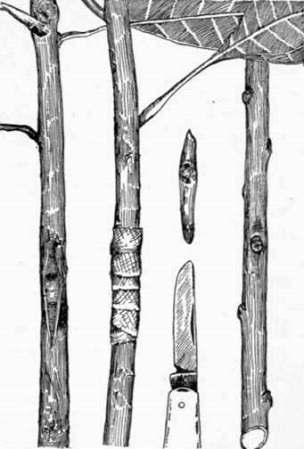
Fig.
11. Shield-budding the mango. On the left, a bud properly inserted;
next, an inserted bud wrapped with a strip of waxed cloth; above the
knife-point, a properly cut bud; and on the right, budwood of desirable
character.
Various
methods of budding, beginning with the patch-bud, have been tried at
different times, but shield-budding (Fig. 11) is the only one which has
proved altogether satisfactory for nursery purposes. The method is the
same as that used with citrus fruits and the avocado. Having been less
extensively practiced, however, mango budding is less thoroughly
understood, and it is not a simple matter to judge the condition of the
stock plants and the bud wood without experience.
The best
season for budding the mango in Florida is generally considered to be
May and June, but the work is done successfully all through the summer.
It is necessary to bud in warm weather, when the stock plants are in
active growth.
When seedlings have attained the diameter of a
lead-pencil they can be budded, although they are commonly allowed to
grow a little larger than this. The proper time for inserting the buds
is when the plants are coming into flush, i.e., commencing to push out
wine-colored new growth. When they are in this stage, the bark
separates readily from the wood; after the new growth has developed
further and is beginning to lose its reddish color, the bark does not
separate so easily and budding is less successful.
The budwood
should be taken from the ends of young branches, but usually not from
the ultimate or last growth; the two preceding growths are better. It
is considered important that budwood and stock plant be closely
similar, in so far as size and maturity of wood are concerned. If
possible, branchlets from which the leaves have fallen should be
chosen. In any event, the budwood should be fairly well ripened, and
the end of the branchlet from which it is taken should not be in active
growth.
The incision is made in the stock plant in the form of a
T or an inverted T, exactly as in budding avocados or citrus trees. The
bud should be rather large, preferably 1 1/2 inches in length. After it
is inserted it should be wrapped with waxed tape or other suitable
material.
After three to four weeks the bud
is examined, and if it is green and seems to have formed a union, the
top of the stock plant is cut back several inches to force the bud into
growth. A few weeks later the top can be cut back still farther, and
eventually it may be trimmed off close above the bud, - this after the
bud has made a growth of 8 or 10 inches.
J. E. Higgins1
describes a method of shield-budding which has been successful in the
Hawaiian Islands. So far as known, it has not been used on the mainland
of the United States. Higgins says, "Budding by this method has been
successfully performed on stocks from an inch to three inches in
diameter. . . . Wood of this size, in seedling trees, may be from two
to five years old. It is essential that the stocks be in thrifty
condition, and still more essential that they should be in ' flush.' If
not in this condition, the bark will not readily separate from the
stock. It has been found that the best time is when the terminal buds
are just opening. . The budwood which has been most successfully
used is that which has lost most of its leaves and is turning brown or
gray in color. Such wood is usually about an inch in diameter. It is
not necessary in this method of budding that the budwood shall be in a
flushing condition, although it may be of advantage to have it so. . .
The incision should be made in the stock about six inches in length.
. . . The bud shield should be three to three and a half inches long,
with the bud in the center." After-treatment of the buds is the same as
with the Florida method which has been described: in fact the Hawaiian
method seems distinct only in the size of stock plant and budwood, and
the consequent larger size of the bud.
1 Bull. 20, Hawaii Agr. Exp. Sta.
Crown-grafting
(Fig. 12) is not commonly practiced in Florida, but it has been
successful in Porto Rico. It has also been employed with good results
by H. A. Van Hermann of Santiago de las Vegas, Cuba, and it is said to
have proved satisfactory in Hawaii and in India. W. E. Hess, formerly
expert gardener of the Porto Rico Agricultural Experiment Station, who
has had much experience with the method, says that it has proved more
successful in Porto Rico than budding, and is at the same time superior
to inarching because of the greater rapidity with which trees can be
produced in large quantities. As in budding, success seems to depend
mainly on the condition of stock and cion at the time the graft is
made. Provided the stock is in flush, the work can be done at any
season of the year. For cions, tip ends of branchlets are used. They
should be of about the diameter of a lead-pencil; of grayish, fully
matured, dormant wood; and from 3 to 5 inches in length. A slanting cut
1 to 2 inches long is made on one side, tapering to a point at the
lower end of the cion. The stock may be of almost any size. When young
plants are used they are cut back to 1 foot above the ground, and a
slit about 1 inch long is made through the bark, extending downward
from the top of the stump. The cion is then forced in, with its cut
surface next to the wood, and is tied in place with soft cotton string.
No wax is used. The graft is inclosed in three or four thicknesses of
oiled paper which is wound around the stock and tied firmly above and
below. This is left on for twelve to twenty days, when it is untied at
the lower end to admit air. Fifteen or twenty days later the cions will
have begun to grow and the paper can be removed entirely.
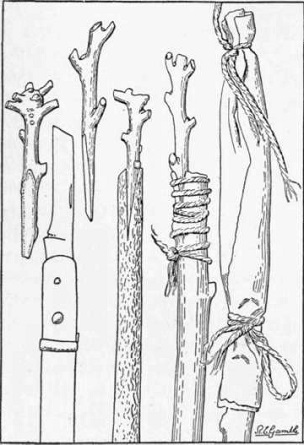
Fig.
12. Crown-grafting the mango. On the left, two cions of proper size and
character; in the center, a cion inserted and another tied in place;
and on the right, the covering of waxed paper which protects the cion
while it is forming a union with the stock.
This method is
applicable not only to nursery stock but also to old trees which it is
desired to topwork. In this case about half of the main branches of the
tree should be cut off at three or four feet from their union with the
trunk. It is necessary to leave several branches to keep the tree in
active growth; this also has a beneficial effect on the grafts by
protecting them from the sun. When the cions are well established,
these branches may be removed or they also may be grafted if more limbs
are necessary to give the tree a good crown. The cions are inserted
under the bark at the cut ends of the limbs, exactly as described for
young stocks, but larger cions may be used.
In Florida many
large trees have been top-worked by cutting off several of the main
branches, close to their union with the trunk, and allowing a number of
sprouts to come out. When these have reached the proper size, they are
budded in the same manner as seedlings.
Throughout the tropics
there are many thousands of seedling mango trees which are producing
fruit of inferior quality. By top-working, these trees could be made to
yield mangos of the choicest Indian varieties. The work is not
difficult and the value of the tree is increased enormously. Perhaps no
other field in tropical horticulture offers such opportunities for
immediate results as this.
The Mango
Botanical
Description
History and
Distribution
Composition
And Uses Of The Fruit
Climate And Soil
Cultivation
Propagation
The Mango Flower
And Its Pollination
The
Crop
Pests And
Diseases
Races and
Varieties
Back to
The Mango Page
|
|